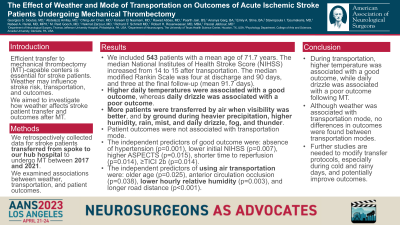The Effect of Weather and Mode of Transport on Outcomes of Acute Ischemic Stroke Patients Undergoing Mechanical Thrombectomy
Friday, April 21, 2023


Georgios S. Sioutas, MD (he/him/his)
Postdoc Research Fellow
Department of Neurosurgery, Hospital of the University of Pennsylvania, Penn Medicine, Philadelphia, Pennsylvania, USA
Philadelphia, PA, US
ePoster Presenter(s)
Introduction: Efficient transfer to mechanical thrombectomy (MT)-capable centers is essential for stroke patients. Weather may influence stroke risk, transportation, and outcomes. We aimed to investigate how weather affects stroke patient transfer and outcomes after MT.
Methods: We retrospectively collected data for stroke patients transferred from spoke to our hub hospital to undergo MT between 2017 and 2021. We examined associations between weather, transportation, and patient outcomes.
Results: We included 543 patients with a mean age of 71.7 years. The median National Institutes of Health Stroke Score (NIHSS) increased from 14 to 15 after transportation. The median modified Rankin Scale was four at discharge and 90 days, and three at the final follow-up (mean 91.7 days). Higher daily temperatures were associated with a good outcome, whereas daily drizzle was associated with a poor outcome. More patients were transferred by air when visibility was better, and by ground during heavier precipitation, higher humidity, rain, mist, and daily drizzle, fog, and thunder. Patient outcomes were not associated with transportation mode. The independent predictors of good outcome were: absence of hypertension (p=0.001), lower initial NIHSS (p=0.007), higher ASPECTS (p=0.015), shorter time to reperfusion (p=0.014), ≥TICI 2b (p=0.014). The independent predictors of using air transportation were: older age (p=0.025), anterior circulation occlusion (p=0.038), lower hourly relative humidity (p=0.003), and longer road distance (p < 0.001).
Conclusion : During transportation, higher temperature was associated with a good outcome, while daily drizzle was associated with a poor outcome following MT. Although weather was associated with transportation mode, no differences in outcomes were found between transportation modes. Further studies are needed to modify transfer protocols, especially during cold and rainy days, and potentially improve outcomes.
Methods: We retrospectively collected data for stroke patients transferred from spoke to our hub hospital to undergo MT between 2017 and 2021. We examined associations between weather, transportation, and patient outcomes.
Results: We included 543 patients with a mean age of 71.7 years. The median National Institutes of Health Stroke Score (NIHSS) increased from 14 to 15 after transportation. The median modified Rankin Scale was four at discharge and 90 days, and three at the final follow-up (mean 91.7 days). Higher daily temperatures were associated with a good outcome, whereas daily drizzle was associated with a poor outcome. More patients were transferred by air when visibility was better, and by ground during heavier precipitation, higher humidity, rain, mist, and daily drizzle, fog, and thunder. Patient outcomes were not associated with transportation mode. The independent predictors of good outcome were: absence of hypertension (p=0.001), lower initial NIHSS (p=0.007), higher ASPECTS (p=0.015), shorter time to reperfusion (p=0.014), ≥TICI 2b (p=0.014). The independent predictors of using air transportation were: older age (p=0.025), anterior circulation occlusion (p=0.038), lower hourly relative humidity (p=0.003), and longer road distance (p < 0.001).
Conclusion : During transportation, higher temperature was associated with a good outcome, while daily drizzle was associated with a poor outcome following MT. Although weather was associated with transportation mode, no differences in outcomes were found between transportation modes. Further studies are needed to modify transfer protocols, especially during cold and rainy days, and potentially improve outcomes.
